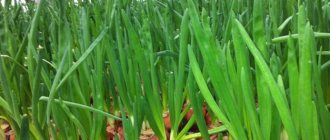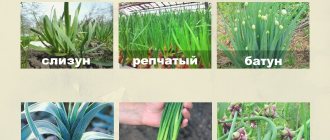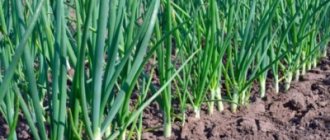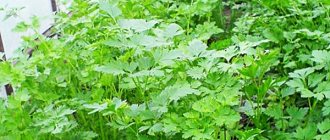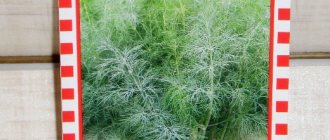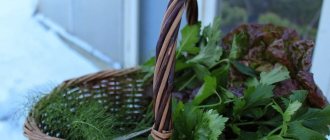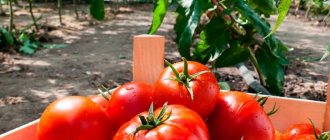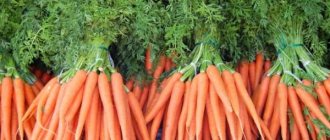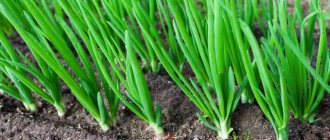The best varieties of onions for growing in a greenhouse
To produce greens in a greenhouse, onion varieties with a large number of rudiments are selected to ensure high profitability of cultivation. Varieties with a short growing season - 90-100 days - are best suited. For spring planting, the duration of the variety's dormant period does not matter. In addition to the listed characteristics, it is important to pay attention to the quality of the pen.
Stuttgarter Risen (Stuttgart)
The well-known variety Stuttgarter Riesen from German breeders is distinguished by particularly high productivity - the yield of greens is up to 90%. One small onion produces 2-3 powerful or 4-6 medium green sprouts. The feather is juicy and tender, with a rich taste.
The “Stuttgarten Riesen” variety produces greenery up to 90% of the volume of planted onions
Bessonovsky
A popular onion variety in the middle zone. It is successfully grown for greenery in open ground and inside a greenhouse. It belongs to the multi-primordial, early-ripening varieties, producing up to 80% green mass. The feather is thick and dense, has a good presentation.
“Bessonovsky” onions are grown from seeds or sets
Chalcedony
A widespread variety that is suitable for cultivation in various regions. It has an average growing season and dormancy. Each small bulb contains 2-3 rudiments, and a large one contains 4-6. The yield of green mass is 50% and 70%. Chalcedony's feathers are powerful and juicy, have a rich color and a pronounced taste.
The "Chalcedony" variety has a pungent taste of the heads
Karatalsky
A highly rated variety for greenhouses by professionals. It is characterized by a short dormant period, early ripening and multiple buds (3-7 buds). Gives a bountiful harvest of greenery (70%) even in conditions of lack of moisture and insufficient soil fertility. The feather is strong, juicy and tender, with a good medium-hot taste.
Variety “Karatalsky” is early ripening, unpretentious in care, excellent for winter storage
Rostov local
The number of primordia is more than 3, the dormant period is average. When planting bulbs larger than 5 cm and proper feeding, a significant amount of greenery is obtained - 60-75%. Characterized by fast distillation and sharp pungency in taste. The feather is bright green, powerful and juicy.
The feather of the “Rostov local” onion quickly increases in height
Landing nuances
Onions are grown in the spring both in the open area, in a greenhouse, and indoors.
In order for greenery to actively grow, it is important to prepare light soil and saturate it with nutrients.
In the open ground
Planting seedlings in the spring at the dacha is done using any of two methods:
- Mostovoy. The bulbs are placed in the ground or in sawdust, pressing against each other. The root part should be directed downwards. The bulbs are covered with 3 cm of soil.
- Tape. Several beds are made in the garden, each of which should be 15 cm away from its neighbors. The bulbs are placed at a distance of 4 cm from each other.
The landing site should be:
- well lit;
- cleared of weeds;
- selected after the growth of potato bushes, pumpkin crops, tomatoes;
- have non-acidic soil.
A few days before planting, the soil is moistened. Onions in the beds are covered with polyethylene for a week to protect them from possible spring frosts. You cannot keep the film on for longer, otherwise the roots will rot.
In the greenhouse
Since onions grow faster in greenhouse conditions than in open ground, they can be grown in late winter and early spring from both seeds and sets.
The main condition for good development of greenery is sufficient heat and lighting. Onion feathers need an abundance of ultraviolet light; daylight hours should be 12-14 hours. Therefore, it is advisable to use artificial lighting sources. Moreover, it is better for the lamps to stand vertically, then the onion feathers will grow evenly, turning a rich green color.
Onions should be planted in a greenhouse in high-quality, breathable soil, saturated with organic and mineral substances. A bucket of compost, 15 g of potassium chloride, 30 g of superphosphate per 1 m2 are first added to the soil.
It is best to equip racks for growing onions to place containers on them. Some farmers use hydroponic greenhouses. In them, onions are placed in water.
The principle of planting seedlings is the same as in open ground. But planting seeds is more difficult. They do the following:
- In the container, straight furrows are made on the soil at a distance of 15 cm from each other.
- The seeds are planted to a depth of 1.5-2 cm.
- The distance between nigellas in a row should be 1 cm.
- The furrows are covered with earth.
To quickly germinate onions, you need to maintain a room temperature of 18-20°C during the day and about 15°C at night. When greenery appears, the greenhouse is heated to 22°C.
At home
The most common way to grow onions for greens on a windowsill is in containers. They use store-bought substrate; no fertilizer is needed. The soil is moistened with warm water. The bulbs are immersed in water with the root part down and left for 2 days. Then they are transferred to the ground and buried shallowly so that the top sticks out.
After pecking the greens, the containers are kept in a room where the temperature is 25-27°C. When the feathers extend by 2-3 cm, the heating is reduced to 22°C. Water the onions twice a week. You cannot keep greens near a heating radiator that is on, otherwise the leaves will wither, or on a window where there is a draft. After warm weather sets in, greens can be grown on the balcony.
Many growers grow onions using hydroponics. In this case, the harvest can be obtained not only in spring, but also in winter. The bulbs are planted in special blocks of mineral wool, moistened with water and treated with fertilizers.
The distance between the rows is 3 cm, between the bulbs - 2 cm. The sets are covered with perlite or vermiculite, making a layer of about 2 cm.
Until germination, onions are kept in a shaded and cool place. When the sprouts hatch, the temperature is raised to 23-25°C, daylight hours are set to 12-14 hours. The substrate should always be moderately moist.
To save space, you can grow onions for greens in a bottle with the top cut off. Several holes are made in the container, the diameter of which should match the size of the set. The bulbs are inserted into the holes. Soil is poured into the bottle. Watering is carried out from below, placing the container in water.
In spring, onions grow well in sawdust. They hold moisture well, so you rarely have to water them. However, before use, the wood material must be scalded with boiling water. Or keep it in a manganese solution for several hours. You can sow onions in the same substrate once, the next time you take new sawdust.
You can also grow onions for greens in egg cells. Before use, they are disinfected with hydrogen peroxide. Then cut out the bottom. Next, it remains to place the cells in a tray with water to moisten the substrate.
When can you plant onions in a greenhouse?
Planting early onions in a greenhouse at the end of winter or early spring is possible only if there is a heating system. At temperatures below 10 °C, the crop grows poorly and is often affected by fungal diseases. In view of this, onions are planted in an unheated greenhouse or greenhouse after the snow has completely melted. For the middle zone this is April.
Too short daylight hours in the first half of the growing season are compensated by artificial lighting. Otherwise, the feathers will be thin and pale, and the harvest volume will be critically low.
Chinese cabbage (Pak choi)
Any variety of Chinese cabbage grows quite quickly, but leafy varieties are the fastest.
Pak choy cabbage is distinguished by its cold resistance (its seeds germinate at a temperature of 3-4°C, and adult plants can withstand frosts down to -4°C) and ultra-earliness (the first succulent leaves can be removed after 15-25 days, and normal rosettes - after 45 days). Kale is not afraid of partial shade; moreover, planting in a shaded area reduces the likelihood of flowering. The most favorable temperature for cabbage is 15-20°C.
Pak choi is planted according to the pattern of 20-30 centimeters between plants and 25-35 centimeters between rows. Kale does not require special conditions or agricultural technology; timely watering and one or two fertilizing with herbal infusion or mullein infusion are sufficient.
How to grow onions for greens in a greenhouse
To obtain high-quality onion feathers, suitable conditions must be created in the greenhouse:
- temperature - 10-25 oC;
- humidity - 70-80%;
- regular watering;
- frequent ventilation;
- daylight hours - at least 12 hours.
Important!
The higher the temperature in the greenhouse, the faster the feather grows. Green feathers are obtained through second year bulbs, large sets and seeds. The first method is the most common and simplest. But for high profitability, you need to correctly select and prepare planting material. Forcing feathers from onion sets is a simple process, but the greens become thin. Obtaining feathers from seeds in a greenhouse is the most difficult approach, which is not used on an industrial scale.
Bulbs
To obtain greens, they usually choose well-preserved bulbs, the diameter of which does not exceed 3-4 cm. Sometimes larger turnips (5-6 cm) are used, but in this case the yield growth decreases, and the planting itself takes up a lot of space. Single-bud bulbs produce 30% of the planting material’s greenery mass, multi-bud bulbs – up to 90%.
Planting bulbs is carried out in several stages:
- Stimulation. In order for the bulb to finally wake up and begin to grow, the top of it is cut off up to the shoulders. Additionally, you can make shallow vertical cuts in the neck.
- Land preparation. The area of the greenhouse allocated for onions must be thoroughly moistened before planting.
- Landing. To obtain greenery in a greenhouse, onions are usually planted in a bridge method - they are laid tightly next to each other. The turnips are not deepened, but only slightly pressed to the ground. The top is lightly sprinkled with wet peat or humus.
Advice! Soaking the bulbs in a solution of copper sulfate before planting helps increase the volume and usefulness of feathers.
How to plant onion sets on greens in a greenhouse
To grow greens in a greenhouse, select large onion sets - 1.5-2 cm. To “peck” the sprouts faster, the tops need to be cut off. To speed up germination, it is also practiced to immerse the selected seeds in warm water for a day. In this case, the greens “hatch” 4-5 days earlier.
Most often, feathers are grown through onion sets for sale. With good lighting and fertilizing, the output is an impressive amount of greenery. It is planted tightly, slightly buried in the ground. Sprinkle a little moistened soil on top. To continuously obtain greenery, planting is done every two weeks.
Seeds
From seeds (nigella) they mainly practice forcing greens for personal consumption. The highest rates of germination are achieved by grains that have been stored for no more than two years. Before sowing, nigella is checked by placing a small amount in a wet cloth. If at least 80% of the seeds hatch, they are suitable for growing feathers.
Seeds are prepared for planting in this way:
- Soak in warm water for 24 hours (change the liquid 3 times).
- Immerse for an hour in a solution of potassium permanganate.
- Keep the antifungal drug in liquid form for 10-12 hours.
The nigella is dried and sown to a depth of 1.2-1.5 cm (the heavier the soil, the smaller the depression). A distance of 1.5 cm is maintained between the rows. The sowing density is calculated as follows: 2 g of seeds are consumed per 1 m.
Advice! If you pre-mix nigella with chalk, the sowing will be more uniform.
The sprouts that “hatch” from the ground are thinned out, leaving 2 cm between them. When 2-3 leaves are formed, the row is broken through, leaving 3-5 cm between adjacent sprouts.
Soil preparation
The method of growing onions in a greenhouse depends on its variety and variety. Most often, bulbous cultivation is used indoors, since this method requires minimal effort. Using the seed method significantly increases the harvest time. With the seedling method, additional transplantation of the resulting sprouts to a permanent place is necessary, which also increases labor intensity.
The seedling method is used to grow leeks. Initially prepared seeds are sown in special seedling containers or peat pots, watered abundantly and covered with film. Before germination, containers are kept at a temperature of 13 to 16 degrees. When the sprouts appear, place the containers in a well-lit place and raise the temperature to 21 degrees.
With the bulbous growing method, small-sized bulbs are selected for planting. To increase productivity, selected planting material is heated for 24 hours at a temperature of 40 degrees. After this, the neck of each bulb is cut off with garden shears to facilitate access to oxygen and rapid growth of greenery.
Light sandy soil fertilized with humus and peat is suitable for growing onions. Before planting, the soil must be dug up and fertilizers applied. For each square meter add:
- 10 liters of compost;
- 15 g sodium chloride;
- 30 g superphosphate.
If garden soil is used for planting, it is preferable to take soil where tomatoes, eggplants, carrots or beets grew. The same soil can be used to produce 3-4 onion harvests.
You can grow bulbous plants not on the ground, but on sawdust. They do not need to be replaced and retain moisture well. Fine sawdust is poured onto beds or racks, and wood ash and ammonium nitrate are poured on top of them. Ash deoxidizes wood material, and ash saturates the bulbs with nitrogen. With this growing method, additional feeding is not required.
Advice!
Garden soil is taken from areas where tomatoes, eggplants, carrots, and beets grew.
Fertilizers are applied per 1 m² of soil:
- superphosphate granules 30 g;
- sodium chloride crystals 15 g;
- compost 8-10 kg.
Add ash and ammonium nitrate granules if sawdust is used as a substrate. They are scattered on top. Ash is a deoxidizer and supplier of microelements, saltpeter feeds the bulbs with nitrogen. No other feeding is needed.
Top dressing
Experienced agronomists annually fertilize the soil in the greenhouse in the fall. Therefore, there is no need to apply additional fertilizer to the onions. If pale and thin feathers are formed, you can spray with a solution of urea or another suitable preparation. At the end of the procedure, the greens are doused with clean water.
Thin and pale onions in the greenhouse need to be fed
When growing feathers for sale, greenhouse owners strive to get the harvest as quickly as possible. To do this, they carry out 2 or 3 feedings. At the beginning of the growing season, nitrogen and potassium are added. Before harvesting onions, “Gumisol”, “Vermistil” and other complex preparations are used.
Radish
Our dearly beloved radishes also work well when planted in early spring.
Radish seeds can be scattered directly on the snow thrown onto the greenhouse ridges, and after 20-30 days you can enjoy the first root crops. For early planting of radishes, it is recommended to use special early-ripening spring varieties, and it is best to select only the largest seeds (plants with small seeds are more likely to grow into arrows). Radish is light-loving; it is preferable to grow it on the sunny side. And if you also dust the bed with ash before planting, which will provide the radishes with the necessary potassium, you will definitely not be left without a harvest.
For more information about the agricultural technology of growing radishes, read the article: Growing radishes: how to achieve a harvest
Diseases and pests
The combination of high humidity and low temperatures in a greenhouse often leads to fungal diseases. They appear as spots of varying colors and areas of rot on the lower or upper half of the onion. The most common pests are onion fly, stem nematode and secretive proboscis.
Disease and pest control is carried out primarily through prevention. Effective methods are annual soil replacement in the greenhouse and fruit rotation. Wood ash is effective against onion flies. If the use of insecticides or fungicides is necessary, biological compounds are chosen. They decompose in just a few days, after which the onions can be safely eaten.
Features of proper care: tips for beginning gardeners
For effective crop germination, you must adhere to the following steps:
- water the plants moderately and promptly using a sprayer, as a strong stream of water washes out the seeds and nails the feather to the ground;
- loosen the soil for a full flow of oxygen;
- weed the beds;
- ventilate without creating drafts;
- apply fertilizers before planting and during onion growth;
- maintain air humidity within 70-80%.
Due to the short growing period of feathers, chemical mixtures cannot be used to control pests or diseases.
To prevent their occurrence, before planting onions in the ground in winter and at other times, the greenhouse should be disinfected. If diseased specimens are discovered during growth, they are immediately removed, and the soil under them is replaced with a new one and treated with wood ash.
Greens are a storehouse of vitamins; in addition, the benefits of onions are invaluable during the cold season, as they are natural antibiotics. How to store and grow green onions in a plastic bottle, sawdust, water without soil in winter and at the end of summer - read our articles.
Harvesting
The harvest period depends on the onion variety and the conditions created in the greenhouse. Usually it takes 4 to 6 weeks after planting until this point. Leaves 25-40 cm long (from ground level) are ready for sale and consumption. Greens of 50 cm are considered non-commercial.
Cleaning is carried out in the following way:
- The onion is cut at the root with a knife.
- Cut off the bottom.
- Hold the onion with one hand, and pull out the feather with the other.
- Remove the transparent film from the white part.
- Packed in newspaper or cellophane.
Commercial length of green onions is 25-40 cm
Spinach
Spinach is a storehouse of various vitamins and minerals, which means it is an indispensable food product in the spring.
It is also very advisable to prepare spinach seeds for sowing. They are soaked in water for a day or two, changing the water periodically. Spinach is planted at a distance of 10 centimeters between the bushes. Spinach seeds germinate at 4°C. Young spinach plants are frost-resistant down to -6°C. The optimal temperature for growing spinach is 15-18°C; higher temperatures accelerate the ejection of flower stalks and worsen the taste of the leaves.
Spinach, like many other green crops, loves moisture and light. It is necessary to monitor soil moisture and regularly water the plantings (especially on hot sunny days).

